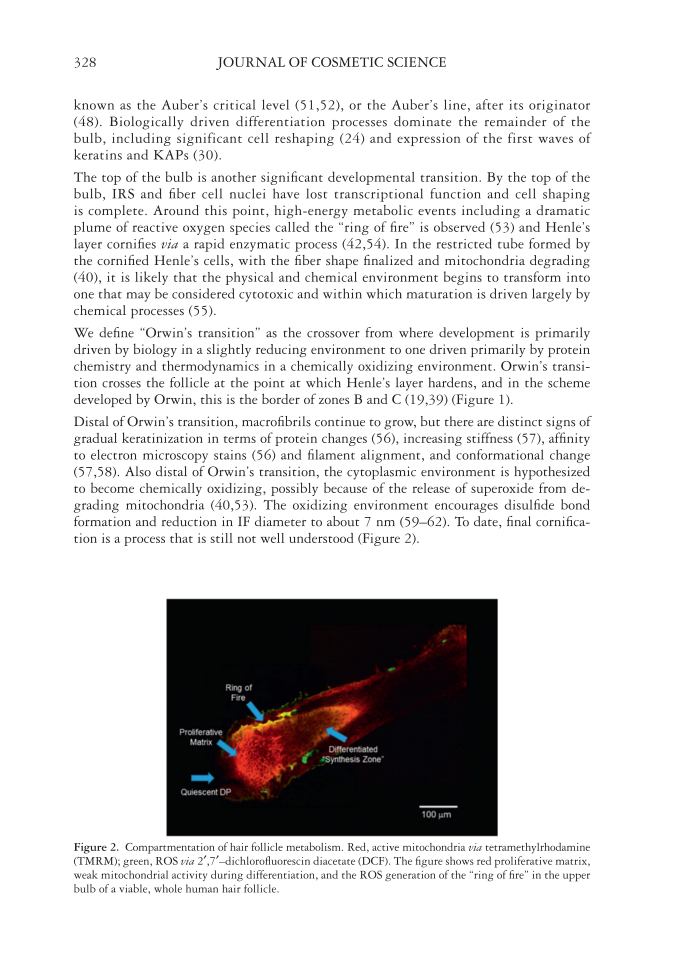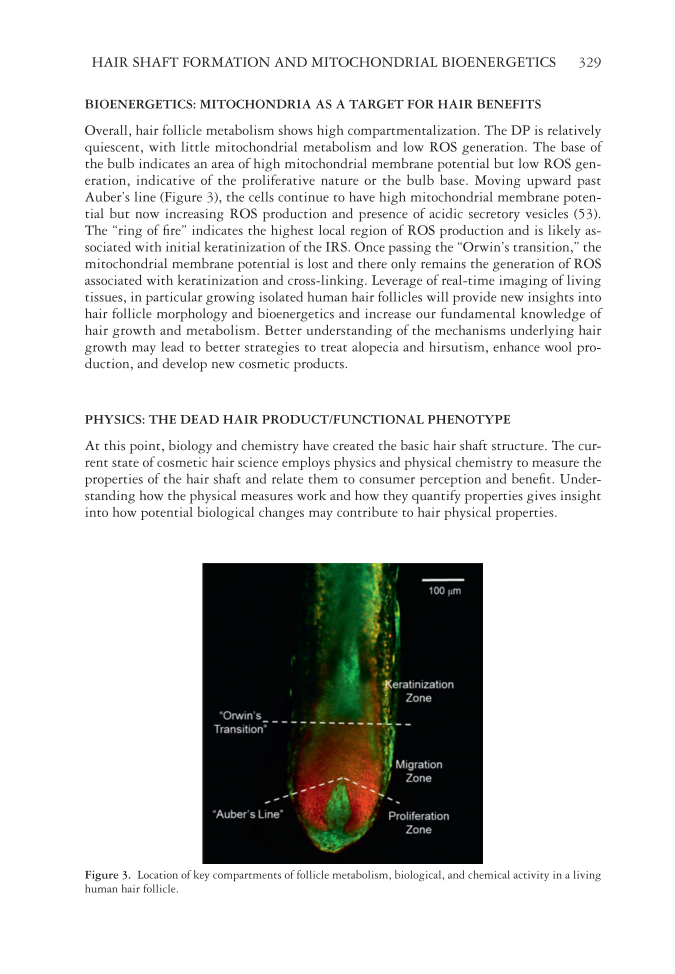JOURNAL OF COSMETIC SCIENCE 328 known as the Auber’s critical level (51,52), or the Auber’s line, after its originator (48). Biologically driven differentiation processes dominate the remainder of the bulb, including significant cell reshaping (24) and expression of the first waves of keratins and KAPs (30). The top of the bulb is another signifi cant developmental transition. By the top of the bulb, IRS and fi ber cell nuclei have lost transcriptional function and cell shaping is complete. Around this point, high-energy metabolic events including a dramatic plume of reactive oxygen species called the “ring of fi re” is observed (53) and Henle’s layer cornifi es via a rapid enzymatic process (42,54). In the restricted tube formed by the cornifi ed Henle’s cells, with the fi ber shape fi nalized and mitochondria degrading (40), it is likely that the physical and chemical environment begins to transform into one that may be considered cytotoxic and within which maturation is driven largely by chemical processes (55). We defi ne “Orwin’s transition” as the crossover from where development is primarily driven by biology in a slightly reducing environment to one driven primarily by protein chemistry and thermodynamics in a chemically oxidizing environment. Orwin’s transi- tion crosses the follicle at the point at which Henle’s layer hardens, and in the scheme developed by Orwin, this is the border of zones B and C (19,39) (Figure 1). Distal of Orwin’s transition, macrofi brils continue to grow, but there are distinct signs of gradual keratinization in terms of protein changes (56), increasing stiffness (57), affi nity to electron microscopy stains (56) and fi lament alignment, and conformational change (57,58). Also distal of Orwin’s transition, the cytoplasmic environment is hypothesized to become chemically oxidizing, possibly because of the release of superoxide from de- grading mitochondria (40,53). The oxidizing environment encourages disulfi de bond formation and reduction in IF diameter to about 7 nm (59–62). To date, fi nal cornifi ca- tion is a process that is still not well understood (Figure 2). Figure 2. Compartmentation of hair follicle metabolism. Red, active mitochondria via tetramethylrhodamine (TMRM) green, ROS via 2′,7′–dichlorofl uorescin diacetate (DCF). The fi gure shows red proliferative matrix, weak mitochondrial activity during differentiation, and the ROS generation of the “ring of fi re” in the upper bulb of a viable, whole human hair follicle.
HAIR SHAFT FORMATION AND MITOCHONDRIAL BIOENERGETICS 329 BIOENERGETICS: MITOCHONDRIA AS A TARGET FOR HAIR BENEFITS Overall, hair follicle metabolism shows high compartmentalization. The DP is relatively quiescent, with little mitochondrial metabolism and low ROS generation. The base of the bulb indicates an area of high mitochondrial membrane potential but low ROS gen- eration, indicative of the proliferative nature or the bulb base. Moving upward past Auber’s line (Figure 3), the cells continue to have high mitochondrial membrane poten- tial but now increasing ROS production and presence of acidic secretory vesicles (53). The “ring of fi re” indicates the highest local region of ROS production and is likely as- sociated with initial keratinization of the IRS. Once passing the “Orwin’s transition,” the mitochondrial membrane potential is lost and there only remains the generation of ROS associated with keratinization and cross-linking. Leverage of real-time imaging of living tissues, in particular growing isolated human hair follicles will provide new insights into hair follicle morphology and bioenergetics and increase our fundamental knowledge of hair growth and metabolism. Better understanding of the mechanisms underlying hair growth may lead to better strategies to treat alopecia and hirsutism, enhance wool pro- duction, and develop new cosmetic products. PHYSICS: THE DEAD HAIR PRODUCT/FUNCTIONAL PHENOTYPE At this point, biology and chemistry have created the basic hair shaft structure. The cur- rent state of cosmetic hair science employs physics and physical chemistry to measure the properties of the hair shaft and relate them to consumer perception and benefi t. Under- standing how the physical measures work and how they quantify properties gives insight into how potential biological changes may contribute to hair physical properties. Figure 3. Loc ation of key compartments of follicle metabolism, biological, and chemical activity in a living human hair follicle.
Purchased for the exclusive use of nofirst nolast (unknown) From: SCC Media Library & Resource Center (library.scconline.org)









































































































